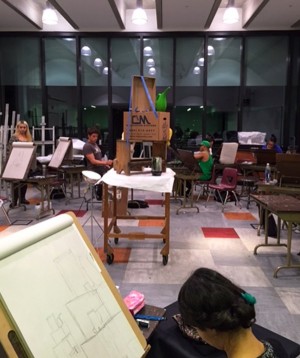Investing in Educational Architecture
Newest City College Building Showcases a Community Investment
The student lounge known as the “Mailbox” sits at the southeast corner of 16th and C streets, next to the new Arts and Humanities Building. (Photo by Lupe Diaz)
December 12, 2014
Benjamin Franklin once said, “An investment in knowledge pays the best interest.” There is no better example of that than what San Diego City College has done with the construction of the new Arts and Humanities complex.
Established in voter-approved Proposition N, the new building consists of approximately 128,378 square feet between starting at the corner of C and 16th streets, modernizing the architecture and design of the college and providing the best suitable place for education.
“It’s great, the new building is great, we have much more space, I love it,’’ says art student Alberto Mendoza. The complex is home to programs such as visual arts, World Cultures, English, speech and foreign languages, and literary journal City Works.
Cynthia Lyons-Dailard, a former student from City College and currently a professor of fine art, says she appreciates the wide space that is available for her classes, making them more productive in terms of time and space.

“It is nice to have spaceable classrooms separated for each class.’’ Lyons-Dailard says that before the new building, in past years a lot of time was lost setting up each drawing class since there were not enough rooms available to have separated areas to teach.
Along the way through the classrooms, the lecture hall, studio space for ceramics and sculptures and computer labs, one can perceive the innovative and modern study environment that is reflected trough the students’ performance.
Its landscaping and design merge with the feel of the surrounding East Village streets.
“Young people are increasingly urban-oriented; they want to live, work and play in a sustainable environment. You see that in the East Village, where people want to live near the digital arts and tech start-ups that are moving in. City College can be a resource for these clusters. The college is one of the best-kept secrets in the city,’’ says David Malmuth, cofounder of IDEA District.
The building project had a budget of $94.6 million, designed by Roesling Nakamura Terada Architects and managed by Thomas J. Fine in collaboration with engineers from Stedman and Dyson Structural Engineers. The facility received the Leadership in Energy & Environmental Design (LEED) Silver Certification due to its sustainable features. For example, all of the classrooms make extensive use of natural daylight, minimizing the use of energy, and the facility takes an ingenious approach to storm water management by returning the water to the ground and minimizing the amount of water that reaches the city’s drain system. The building has a projected energy savings of 572,460 kilowatt hours, 25 percent better than state requirements.
There’s is no doubt the investment that the college has put into this facility will pay off in the future, with the result of more productive classes and better-prepared students who will hopefully appreciate the space and environment.
Read more and comment at medium.com/legend-magazine














